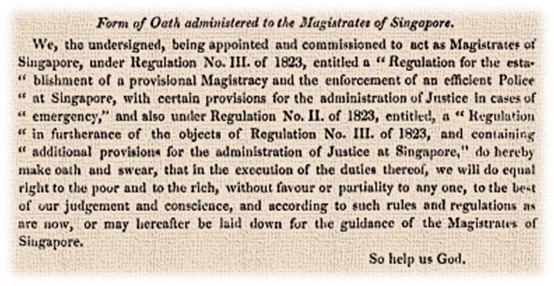Oath of Office and Allegiance of a Judicial Officer
The first form of Judicial Oath can be traced back to the Raffles’ Regulations in 1823, which established the first Magistracy in Singapore. Under Regulation No. VI of 1823, Magistrates were identified as persons who had to “make an oath and swear” to “do equal right to the poor and to the rich, without favour or partially to any one, to the best of [their] judgment and conscience”:

After Singapore became a Crown Colony and came under the direct administration of the British Crown, Ordinance No. 13 (Promissory Oaths) of 1869 required all who assume judicial office to be sworn in by taking two oaths; the Oath of Allegiance and the Judicial Oath when it came into effect. The Oath of Allegiance was a promise to be loyal to the incumbent British monarch, and his or her heirs and successors and it read as follows:

As for the Judicial Oath, any person assuming judicial office had to promise to serve the incumbent monarch in his or her judicial office by doing “right to all manner of people after the laws and usages…without fear or favour, affection or ill-will.”:

Subsequently, with the establishment of the Supreme Court of the Straits Settlements in 1868 and the Inferior Civil and Criminal Courts in 1873, Courts Ordinance No. III of 1873 required all judicial officers appointed to take an Oath of Allegiance and a Judicial Oath before assuming office.
When Singapore became part of the Federation of Malaysia, the Oath of Allegiance and the Judicial Oath for the District Judges and Magistrates were amended for them to swear allegiance to the Yang di-Pertuan Agong. Both the Oath of Allegiance and Judicial Oath were amended to reflect the allegiance to the Republic of Singapore in 1965 when Singapore gained independence as a sovereign state. Ordinance No. 13 (Promissory Oaths) of 1869 was also renamed the Oaths of Office and Allegiance Act. The law on oaths and declarations was later reviewed and consolidated under a single piece of legislation, the Oaths and Declarations Act.
The year 1970 marked an important milestone in Singapore’s judicial history with the passing of the Subordinate Courts Act, which consolidated all the lower courts and designated them as the Subordinate Courts. This Act also combined the Oath of Allegiance and Judicial Oath into a single oath, the Oath of Office and Allegiance of a Judicial Officer and prescribed that all District Judges, Magistrates, Coroners1, Registrars and such other officers of the State Courts have to take this oath prior to the exercise of their duties. All officers appointed as judicial officers of the State Courts have to take this oath before undertaking his or her judicial office and it reads as follows:

1The law subsequently amended removed Coroners as persons required to take the judicial oath under the Act, presumably because a Coroner must concurrently be a District Judge or Magistrate who would already have taken the judicial oath.








